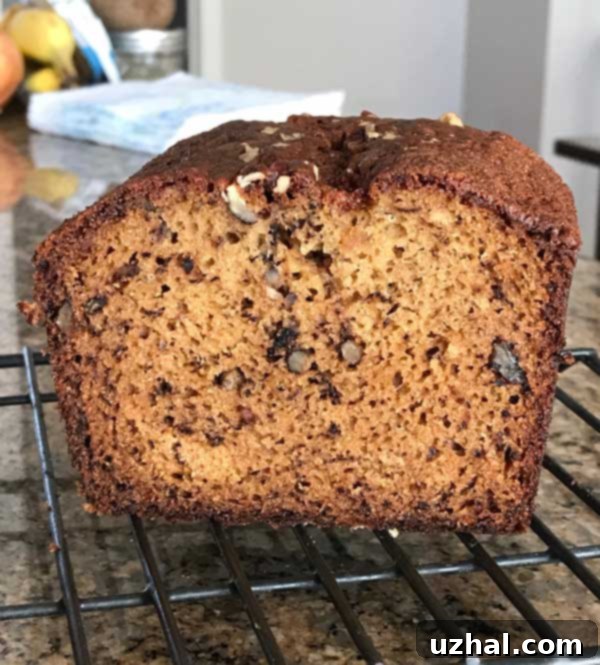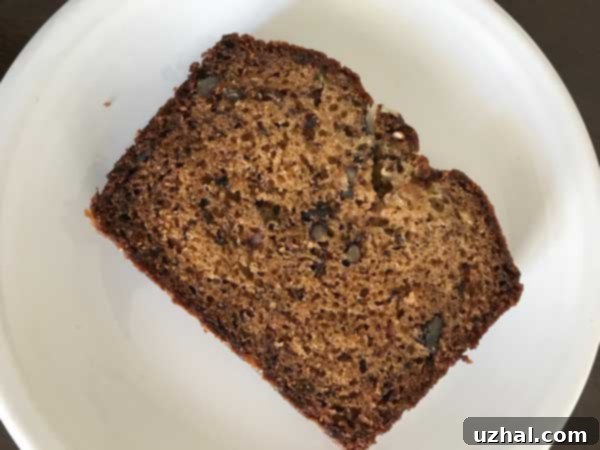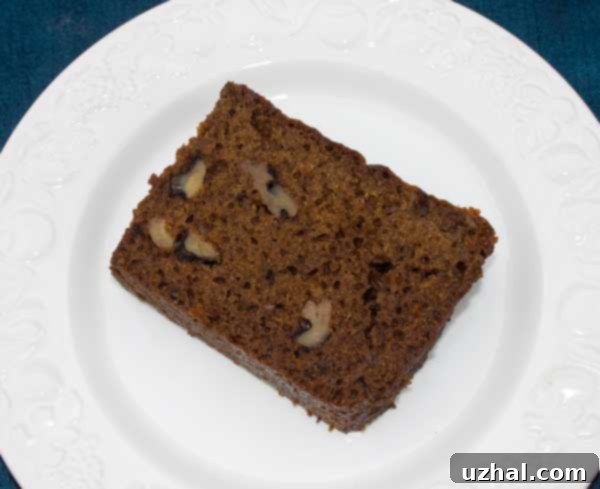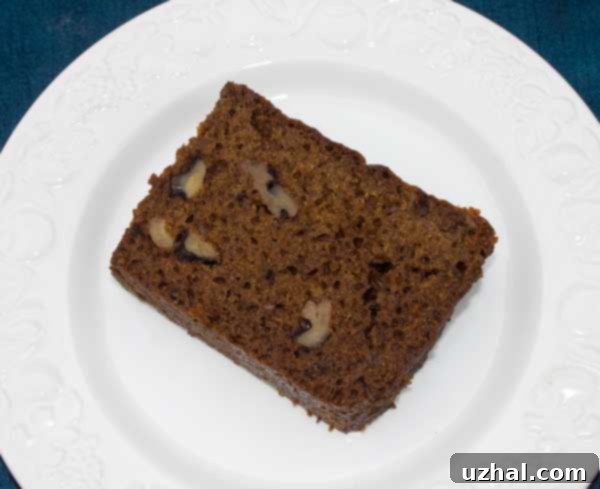The Secret to Perfectly Moist & Dark Banana Bread: Fairmont Hotel’s Low-Temperature Recipe
Just when you thought you had explored every banana bread variation imaginable, a truly distinctive recipe emerges from the renowned Fairmont Hotel. This particular “very dark banana bread” recipe, lovingly shared by Carolyn from Canada who has perfected it over years, offers a unique approach that sets it apart from traditional methods. It promises a banana bread experience unlike any other, characterized by its deep, rich color, incredibly moist texture, and a satisfyingly dense crumb.
The Science of Low-Temperature Baking: Unveiling the Fairmont Method
The most striking aspect of this Fairmont-inspired banana bread recipe is its unconventional baking temperature. Instead of the typical 350°F (175°C) or higher, this loaf bakes at a mere 275°F (135°C) for an extended period of 2.5 to 3 hours. This low and slow approach is not just a quirky detail; it’s a carefully calculated method that profoundly impacts the final product. Baking at a lower temperature ensures a much more even heat distribution throughout the batter. This prevents the edges and top from drying out or burning while the center remains undercooked – a common challenge with denser quick breads.
The extended baking time at a gentle heat allows for superior moisture retention, resulting in an exceptionally moist banana bread that truly melts in your mouth. Furthermore, this method promotes a more gradual and complex development of flavors. The sugars and starches in the bananas and flour have more time to caramelize and undergo the Maillard reaction (the browning reaction responsible for rich, savory flavors), contributing to a deeper, more nuanced taste profile. This slow transformation is key to achieving the distinctive character of this recipe, moving beyond merely cooked bananas to a symphony of mellow, intertwined flavors.

The Role of Baking Soda: Color, Texture, and Flavor Profile
Beyond the unique baking temperature, this recipe calls for a surprisingly generous amount of baking soda – 3.5 teaspoons in the original version. Baking soda, or sodium bicarbonate, is a leavening agent that reacts with acidic ingredients (like the ripe bananas and buttermilk in this recipe) to produce carbon dioxide gas. These gas bubbles get trapped in the batter, causing the bread to rise and become lighter. However, in this particular recipe, the high quantity of baking soda contributes to more than just lift; it’s a major factor in the bread’s striking dark color and its unique, dense texture.
The alkalinity created by the baking soda significantly accelerates the Maillard reaction, even at lower temperatures and without added cocoa powder or excessive brown sugar. This chemical reaction is responsible for the deep, rich brown hue of the banana bread, making it appear almost chocolatey. This intense browning is not just superficial; it permeates the crumb, giving the entire loaf a visually appealing, deeply caramelized look. The interplay between the low baking temperature and the high baking soda content creates a banana bread that is dense yet moist, sturdy enough to slice beautifully, and develops an extraordinary depth of flavor and color.
Some bakers might be concerned about the high amount of baking soda influencing the flavor. While some individuals might perceive a slight “lemony” note or an extended finish, others simply appreciate the complex taste it imparts. Interestingly, the recipe’s creator noted an update: while the original calls for 3.5 teaspoons, she often uses only 2 teaspoons now. Reducing the baking soda amount will still yield a delicious loaf, though it might be slightly less crusty and not quite as intensely dark brown. This adjustment offers flexibility, allowing you to fine-tune the recipe to your preference while still enjoying its unique characteristics.

Mastering the Technique: Flour, Eggs, and Mixing Secrets
Another subtle yet significant deviation from standard banana bread recipes lies in the mixing technique. Most recipes instruct you to add dry ingredients and wet ingredients (like milk) alternately to the creamed butter and sugar mixture. However, this Fairmont recipe specifies adding the flour alternately with the eggs. While this might seem like a minor procedural change, it can have a noticeable impact on the final texture. Eggs, being thicker and more viscous than milk, contribute less additional liquid and can alter how air is incorporated into the batter during mixing.
By alternating flour with eggs, the batter might incorporate less air compared to using milk, contributing to the wonderfully dense and sturdy texture that defines this banana bread. This dense crumb is a desirable characteristic, allowing the bread to hold together perfectly when sliced and making it an ideal candidate for toasting. These small, deliberate changes in technique, combined with the low baking temperature and the specific leavening strategy, collectively produce a banana bread that stands out for its structural integrity, moistness, and rich, deep color.
Achieving Perfection: Tips for a Flawless Loaf
Thanks to Carolyn for bringing this exceptional recipe to light. For those eager to try it, a few crucial tips will ensure success:
- Pan Preparation is Key: This banana bread is known to be quite sticky. Therefore, thorough pan preparation is absolutely essential. Make sure to generously grease and flour your 9×5 inch loaf pan. For an extra layer of protection, consider lining it with parchment paper and then greasing and flouring the parchment as well. This extra step will save you from frustration when removing the cooled loaf.
- Doneness Test: Given the long baking time at a low temperature, determining doneness is vital. While a toothpick inserted into the center should come out clean, the most reliable method is to check the internal temperature with a probe thermometer. The bread is perfectly baked when its internal temperature reaches around 205°F (96°C). If you choose to bake at 300°F (150°C), start checking for doneness at 1.5 hours, but be prepared for a slightly different texture and color outcome.
- Cool Completely: Patience is a virtue when it comes to quick breads. Allow the banana bread to cool completely in the pan before attempting to remove it. This allows the internal structure to set fully, preventing it from crumbling and making it much easier to slice neatly.
- Baking Soda Adjustment: Remember the note about baking soda. If you are sensitive to its taste or prefer a slightly less dark and crusty bread, feel free to reduce the amount from 3.5 teaspoons to 2 teaspoons. The bread will still be delicious and achieve a beautiful brown color.

A Legacy of Flavor: The Fairmont Hotel’s Culinary Heritage
The Fairmont Hotel chain is renowned globally for its luxurious accommodations and, just as importantly, its exquisite culinary offerings. Many of their classic recipes, like this banana bread, become legendary for their distinctive qualities and enduring appeal. This particular recipe, embodying unique baking science and thoughtful technique, is a testament to the kind of culinary excellence that defines the Fairmont experience. It’s a reminder that even a seemingly simple comfort food like banana bread can be elevated to an art form through careful consideration of ingredients and process.
This recipe doesn’t just produce a loaf of banana bread; it invites you into a baking journey that challenges conventional wisdom and rewards you with an exceptionally flavorful and memorable treat. Whether enjoyed for breakfast, as a delightful snack, or served alongside a cup of coffee, this dark, dense, and moist banana bread is sure to become a cherished addition to your recipe collection. Its robust texture makes it perfect for a variety of uses, from simple slices to a base for decadent French toast, offering versatility that matches its undeniable deliciousness.
More Banana Bread Inspiration
- Palmer House Brownies (Again) aka Old Hotel Brownies
- Small Loaf Pan Banana Bread
- Peanut Butter Banana Bread with Chocolate Chips
- Best Ever Banana Bread
- Small Batch Sour Cream Banana Muffins
Recipe

Low Temperature Banana Bread
Anna
Pin Recipe
10 minutes
3 hours
3 hours
10 minutes
Breakfast
American
12
Ingredients
-
2
large
8 oz/ 230 grams very ripe bananas, mashed -
1
cup
plus 2 tablespoons
8 ounces/ 230 grams of granulated sugar -
3 ½
teaspoons
baking soda
(Note: I typically use 2 teaspoons now for a slightly milder flavor and less crusty texture, see notes below)** -
2
large eggs -
1 ¾
cup
plus 2 tablespoons
8 ounces/230 grams all-purpose flour -
¼
cup
vegetable oil -
½
cup
buttermilk -
¼
teaspoon
salt -
1
teaspoon
of vanilla extract
(optional, but recommended for flavor depth) -
¼
cup
toasted and chopped walnuts
(optional, can substitute pecans or chocolate chips)
Instructions
-
Preheat your oven to 275 degrees F (135°C). Prepare a 9×5 inch loaf pan by greasing it thoroughly. For extra non-stick insurance, line the greased pan with parchment paper, then grease and dust the parchment paper with flour as well. This meticulous preparation is crucial, as the finished loaf tends to be quite sticky.
-
In a blender, combine the mashed ripe bananas, granulated sugar, and baking soda. Blend until the mixture is smooth and well pureed. This step ensures an even distribution of ingredients and contributes to the bread’s uniform texture.
-
Transfer the banana mixture from the blender to a large mixing bowl. Add the eggs and the all-purpose flour alternately to the banana mixture, stirring gently until just combined. Be careful not to overmix; slight streaks of flour are acceptable. This alternating method with eggs (rather than milk) contributes to the unique density of the bread.
-
Next, incorporate the vegetable oil, buttermilk, and salt into the batter. Beat with a spoon until everything is thoroughly blended and the batter appears smooth. If using, stir in the vanilla extract and the toasted, chopped walnuts until evenly distributed.
-
Pour the prepared batter into your meticulously prepared loaf pan. Bake in the preheated oven for 2.5 hours. Begin checking for doneness around the 2-hour mark. If you opt to bake at 300°F (150°C), start checking at 1.5 hours.
-
To confirm doneness, the internal temperature of the banana bread should be approximately 205°F (96°C). A probe thermometer is the most accurate tool for this. Once baked, let the loaf cool completely in the pan before carefully removing it. This is essential for clean slices and to prevent sticking.
Notes
**Update on Baking Soda:** While the original recipe specifies 3.5 teaspoons, I’ve found that reducing the baking soda to 2 teaspoons still yields a delicious loaf with a beautiful, rich brown color and maintains the moist, dense crumb. This adjustment can be preferable if you are sensitive to the slight “lemony” note some perceive from the higher amount, or if you prefer a slightly less crusty exterior.
Given the dense and moist nature of this bread, it tends to be quite sticky. It is paramount to thoroughly grease and flour your loaf pan, and ideally, line it with parchment paper that is also greased and floured. This extra step will ensure easy removal and prevent the loaf from sticking to the pan.
dark banana bread, low temperature banana bread, Fairmont Hotel banana bread, moist banana bread
Tried this recipe?
Let us know how it was!
